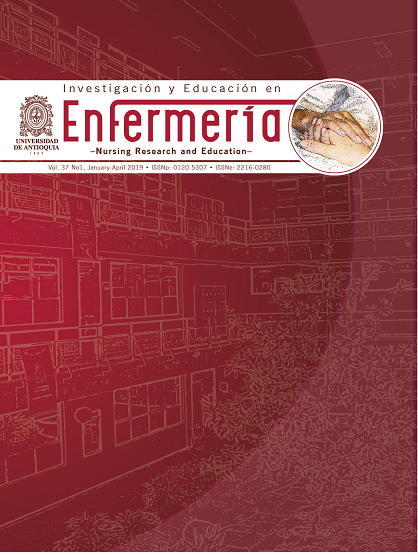Commitment and human tone: the difference between traditional service and nursing care
DOI:
https://doi.org/10.17533/udea.iee.v37n1e05Keywords:
Nursing care, adaptation, nursing theory, nursing processes, nursing methodology research.Abstract
Objective. To describe the transformation of decisive moments that arise within the nurse-patient and family caregiver interaction to turn them into moments of care capable of favoring adaptation.
Methods. In a high complexity hospital in the city of Bogotá (Colombia), a "nursing methodological research"-type study was conducted. It was developed in five stages: 1) identification of the institutional route of patients and their caregivers and, within it, the moments of encounter with nursing; 2) typical day of the nurse; 3) analysis of the nurse-patient and family caregiver encounters; 4) literature review on how to strengthen the nurse-patient and family caregiver relationship; and 5) proposal to transform decisive moments into moments of care.
Results. Patients and their family caregivers usually experience six moments of encounter with nursing that include admission, assessment, satisfaction of basic needs, administration of medication, shift change, and discharge; all of them cross-cut by education and communication. Recognition of experiences during moments of encounter allowed transforming them into moments of nursing care.
Conclusion. The transformation of decisive moments into moments of nursing care to favor adaptation of patients and their family caregivers is consequence of the nursing commitment and human nature expressed in every encounter of the care process.
How to cite this article: Guevara M, Arroyo LP, Pérez MB, Sánchez B. Commitment and Human Tone: the Difference between Traditional Service and Nursing Care. Invest. Educ. Enferm. 2019; 37(1):e05.
Downloads
References
(1) Sánchez B. Cuidado seguro, la nueva tendencia en el cuidado de la salud. Safe care, the new trend in health care. Actual. Enferm. 2011; 14(2):27–32.
(2) León CA. Enfermería ciencia y arte del cuidado. Rev. Cubana Enferm. [Internet]. 2006 [cited 2019 Feb 1]; Available from: http://scielo.sld.cu/scielo.php?script=sci_arttext&pid=S0864-03192006000400007.
(3) Báez-Hernández FJ, Nava-Navarro V, Ramos- Cedeño L, Medina-López OM. El significado de cuidado en la práctica profesional de enfermería. Aquichan. 2009; (2): 127-34.
(4) Vélez C, Pico ME, Ariza C, Castellanos F, Salazar AM. Tendencias y agenda de prioridades de investigación en unidades académicas de Educación superior de Enfermería en Colombia. Cienc. Enferm. 2014; 20(3):11-20.
(5) Biblioteca Virtual en Salud. Terminología DeCS/MeSH. Investigación Metodológica de Enfermería [Internet]. 2019 [cited 2019 Feb 1]. Available from: http://www.bvs.hn/php/decsws.php?lang=es&tree_id=H01.770.644.145.390.634&page=info
(6) Santamaría NP, García LE, Sánchez Herrera B, Carrillo GM. Percepción del cuidado de enfermería dado a los pacientes con cáncer hospitalizados. Rev. Latino-Am Bioética. 2015; 16(30–1):104-127.
(7) Advisory Board. Nursing [Internet]. Washington: Advisory Board; 2016 [cited 2019 Feb 1]. Available from: https://www.advisory.com/es-es/international/topics/nursing
(8) Melnechenko KL. To make a difference: nursing presence. Nurs. Forum. 2003. 38(2):18-24.
(9) Parse RR. Human Becoming: Parse’s Theory of Nursing. Nurs. Sci. Q. 1992; 5(1):35–45.
(10) Du Plessis E. Caring presence in practice: facilitating an appreciative discourse in nursing. Int. Nurs. Rev. 2016; 63(3):377–80.
(11) Fahlberg B, Roush T. Mindful presence: Being “with” in our nursing care. Nursing (Lond). 2016; 46(3):14–5.
(12) Uribe SP, Lagoueyte MI. El papel de la enfermera en el cuidado de los pacientes sometidos a colangiopancreatografía retrógrada endoscópica. Salud, Barranquilla. 2015; 31(1):153–80.
(13) Mahler A. The clinical nurse specialist role in developing a geropalliative model of care. Clin. Nurse Spec. 2010; 24(1):18–23.
(14) Prochet TC, da Silva MJP, Ferreira DM, Evangelista VC. Affection in elderly care from the nurses’ perspective. Rev. Esc. Enferm. USP. 2012; 46(1):96–102.
(15) Marriner AT, Raile M A. Modelos y teorías en enfermería. Madrid: Elsevier; 2007.
(16) Milán Dobson N. Fundamentos de las rutas de cuidados en el paciente pediátrico. Rev. Cuba. Enferm. 2012; 28(2):181–8.
(17) Duque E. Revisión del concepto de calidad del servicio y sus modelos de medición. Innovar, Rev. Cienc. Adm. Soc. 2005; 15(25):64–80.
(18) Hessel JA. Presence in nursing practice: A concept analysis. Holist. Nurs. Pract. 2009; 23(5):276–81.
(19) Kutney-Lee A, McHugh MD, Sloane DM, Cimiotti JP, Flynn L, Neff DF, et al. Nursing: A Key to Patient Satisfaction. Health Aff. 2009; 28(4):669–77.
(20) Luna JR, Concha PJ, Merino Escobar JM. Adherencia de las enfermeras/os a utilizar un modelo teórico como base de la valoración de enfermería. Cienc. Enferm. 2007; 13(1):35-57.
(21) Carvajal G, Montenegro J. Higiene: cuidado básico que promueve la comodidad en pacientes críticos. Enferm. Glob. 2015; 14(40):340-50.
(22) Berdot S, Roudot M, Schramm C, Katsahian S, Durieux P, Sabatier B. Interventions to reduce nurses’ medication administration errors in inpatient settings: A systematic review and meta-analysis. Int. J. Nurs. Stud. 2016; 53:342–50.
(23) Guevara M, Arroyo LP. El cambio de turno: Un eje central del cuidado de enfermería. Enferm Glob. 2015; 401–18.
(24) Sánchez B. Carrillo GM, Barrera L. El plan de transición y egreso hospitalario y su efecto en el cuidado de la salud: una revisión integrada. Div. Cient. 2014; 17(1):13–23.
(25) Fawcett J. The metaparadigm of nursing: International in scope and substance. In: Krause K, Astedt-Kurki P. International perspectives on nursing: A joint effort to explore nursing internationally. Finland: Tampere University; 1992.
Downloads
Published
How to Cite
Issue
Section
License
Copyright (c) 2019 Investigación y Educación en Enfermería

This work is licensed under a Creative Commons Attribution-NonCommercial-ShareAlike 4.0 International License.
Derechos de propiedad / Direitos de Propriedade
English: If the article is accepted for publication, all copyright will be of exclusive property of Investigación y Educación en Enfermería. The text and the graphics included in the publication are exclusive responsibility of the authors and not necessarily reflect the thought of the Editorial Committee.
Español: Si el artículo es aprobado para publicación, todos los derechos son de propiedad de Investigación y Educación en Enfermería. El texto y las gráficas incluidas en la publicación son de exclusiva responsabilidad de los autores y no necesariamente refleja el pensamiento del Comité Editorial.
Português: Se o artigo for aceito para publicação, todos os direitos autorais serão de propriedade exclusiva de Investigación y Educación en Enfermería. O texto e os gráficos incluídos na publicação são de responsabilidade exclusiva dos autores e não refletem necessariamente o pensamento do Comitê Editorial.















